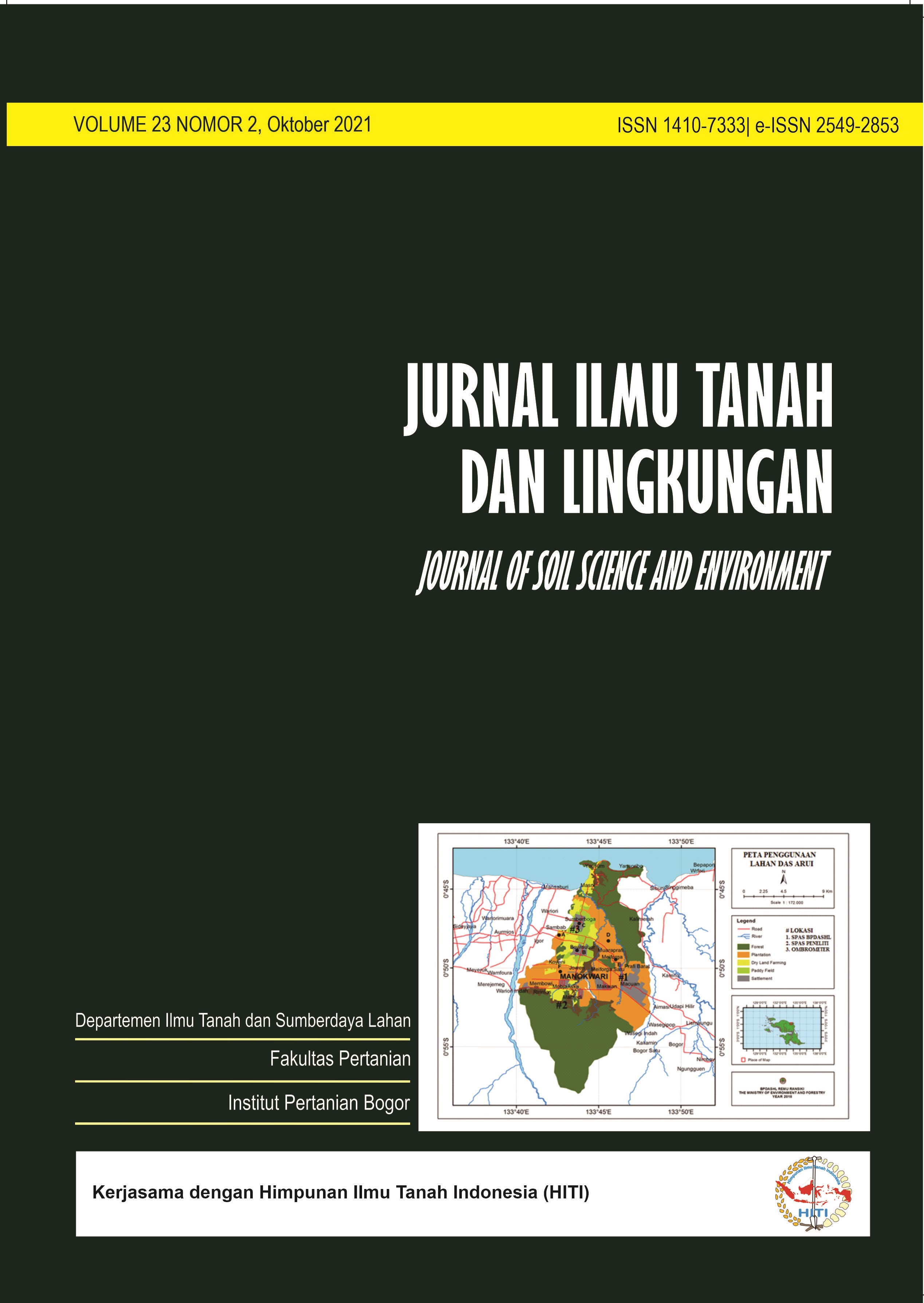Impact of Land Use and Climate Changes on Flood Inundation Areas in the Lower Cimanuk Watershed, West Java Province
Abstrak
Land use and climatic changes potentially affect the surface runoff and inundation in watershed zones. Every year, the outflow of the Cimanuk River causes floods across the majority of the upper area of the Cimanuk Watershed, as well as the lower area. This study aimed to assess the impact of climatic and land use changes on future flood inundation in the Lower Cimanuk Watershed using a RRI model. Land-use change has been prepared by modeling using a multi-layer perceptron neural network and Markov Chain approach, while climate change using HadGEM2-ES global climate model data under scenarios RCP4.5. In particular, the forest area was projected to decline in this watershed zone, from 19.54% of the total area in 2019 to 17.73% in 2050. Similarly, the area of paddy fields was predicted to decline from approximately 34.36% in 2019 to 29.65% in 2050. In contrast, other types of land use such as dryland agriculture, mixed dryland agriculture, and settlements were projected to increase in the future. The coverage of the simulated flood inundation area using the Rainfall-Runoff Inundation model estimated to reach 179.4 km2 in 2019. The simulation results showed an increase in flood inundation areas in 2030 and 2050, alongside changes in land use and climate. The areas affected by flood inundation were estimated to reach 253.3 km2in 2030. This coverage was expected to increase by 311.9 km2 in 2050, with severely affected land uses including settlements, dry land agriculture, mixed dry land agriculture, paddy fields, and ponds.
Unduh
Referensi
Asdak C., S. Supian, and Subiyanto. 2018. Watershed management strategies for flood mitigation: A case study of Jakarta’s flooding. Weather and Climate Extremes, 21: 117–122.
Berihun M.L., A. Tsunekawa, N. Haregeweyn, D.T. Meshesha, E. Adgo, M. Tsubo, T. Masunaga, A.A. Fenta, D. Sultan, M. Yibeltal, and K. Ebabu. 2019. Hydrological responses to land use/land cover change and climate variability in contrasting agroecological environments of the Upper Blue Nile basin, Ethiopia. Science of the Total Environment, 689: 347–365.
Boer, R., and A. Faqih. 2004. An Integrated Assessment of Climate change Impacts, Adaptation and Vulnerability in Watershed Areas and Communities in Southeast Asia, Report from AIACC Project No. AS21 (Annex C, 95-126) International START Secretariat, District of Columbia, Washington.
Chow V.T., D.R. Maidment, and L.W. Mays. 1988. Applied Hydrology. McGraw-Hill Book Company, New York, USA.
Collins W.J., N. Bellouin, M. Doutriaux-Boucher, N. Gedney, P. Halloran, T. Hinton, J. Hughes, C.D Jones, M. Joshi, S. Liddicoat, G. Martin, F. O'Connor, J. Rae, C. Senior, S. Sitch, I. Totterdell, A. Wiltshire, and S. Woodward. 2011. Development and evaluation of an Earth-System model – HadGEM2. Geosci. Model Dev., 4(4), 1051-1075.
Dingman, S.L. 1994. Physical hydrology. MacMillan Publishing Co., New York, USA.
Eastman J.R. 2012. IDRISI Selva manual and tutorial manual version 17. Clark University, Worcester, USA.
Faqih A., R. Hidayat, S.D. Jadmiko, and Radini. 2016. Iklim historis dan skenario perubahan iklim di Indonesia: Analisis dan pemodelan iklim. United Nation Development Programme (UNDP), Kementrian Lingkungan Hidup dan Kehutanan (KLHK) [in Indonesia].
Funk C.C., P.J. Peterson, M.F. Landsfeld, D.H. Pedreros, J.P. Verdin, and J.D. Rowland. 2014. A quasi-global precipitation time series for drought monitoring. U.S. Geological Survey Data Series (832), 4.
He Y., K. Lin, and X. Chen 2013. Effect of Land Use and Climate Change on Runoff in the Dongjiang Basin of South China. Mathematical Problems in Engineering, 2013.
Húska1 D., L. Jurík, L. Tátošová, K. Šinka, and J. Jakabovičová 2018. Cultural landscape, floods and remote sensing. Journal of Ecological Engineering, 18 (3): 31–36.
Indonesian National Board for Disaster Management (BNPB). 2019. https://www.bnpb.go.id/infografis. [in Indonesia]
Indonesian National Board for Disaster Management (BNPB). 2020. https://www.bnpb.go.id/informasi-bencana. [in Indonesia]
Intergovernmental Panel on Climate Change (IPCC). 2017. Towards new scenarios for analysis of emissions, climate change, impacts, and response strategies. Technical summary, Noordwijkerhout, Netherlands.
Jadmiko S.D., D. Murdiyarso, and A. Faqih. 2017. Koreksi bias luaran model iklim regional untuk analisis kekeringan. Jurnal Tanah dan Iklim, 41(1): 25-36. [in Indonesia]
Kudo S., T. Sayama, A. Hasegawa, and Y. Iwami. 2015. Assessment of climate change impact on flood discharge and inundation in the Solo River Basin, Indonesia. Journal of Japan Society of Civil Engineers, Ser. B2 (Hydraulic Engineering), 59: 1321-1326.
Moriasi D.N., J.G. Arnold, M.W. Van Liew, R.L. Bingner, R.D. Harmel, and T.L. Veith 2007. Model evaluation guidelines for systematic quantification of accuracy in watershed simulations. Trans ASABE 50(3): 885–900.
Moss R.H., J.A. Edmonds, K.A. Hibbard, M.R. Manning, S.K. Rose, S.P. Van Vuuren, T.R. Carter, S. Emori, M. Kainuma, T. Kram, G.A. Meehl, J.F.B. Mitchel, N. Nakicennovic, K. Riahi, S.J. Smith, R.J. Stouffer, A.M. Thomson, J.P. Weyant, and T.J. Wilbanks. 2010. The next generation of scenarios for climate change research and assessment. Nature, 463: 747-756.
Mwangi, H.M., S. Julich, S.D. Pati, M.A. McDonald, and K.H. Feger. 2016. Relative contribution of land use change and climate variability on discharge of upper Mara River, Kenya. Journal of Hydrology: Regional Studies 5, 2016, 244–260.
Narulita I., and W. Ningrum. 2018. Extreme flood event analysis in Indonesia based on rainfall intensity and recharge capacity. IOP Conf. Ser.: Earth Environ. Sci. 118: 012045.
Nash J., and J.V Sutcliffe. 1970. River flow forecasting through conceptual models 1: A discussion of principles, J. Hydrol, 10: 282–290.
Nastitia K.D., Y. Kima, K. Junga, and H. An. 2015. The application of Rainfall-Runoff-Inundation (RRI) model for inundation case in upper Citarum Watershed, West Java-Indonesia. Procedia Engineering, 125: 166 – 172.
Naylor, R.L., D. S. Battisti, D.J. Vimont, W.P. Falcon, and M.S. Burke 2007. Assessing risks of climate variability and climate change for Indonesian rice agriculture. Proceedings of the National Academy of Sciences of the United States of America, 104 (19): 7752–7757.
Nugroho P., D. Marsono, P. Sudira, and H. Suryatmojo. 2013. Impact of landuse changes on water balance. Procedia Environ Sci., 17: 256–262.
Piani, C., J.O. Haerter, E. Coppola. 2010. Statistical bias correction for daily precipitation in regional climate models over Europe. Theoretical and Applied Climatology, 99(1–2): 187–192.
Ridwansyah I., A. Sapei, and M. Raimadona. 2012. Applying SWAT to predict impact of landuse change on hydrological response in upper Cimanuk catchment area. In: The 5th international remote sensing and GIS workshop series on demography, land use-land cover and disaster, Bandung, Indonesia.
Ridwansyah I., M. Yulianti , Apip, S. Onodera, Y. Shimizu, H. Wibowo, and M. Fakhrudin 2020. Limnology, 21: 487–498.
Sayama T. 2017. Rainfall-Runoff-Inundation (RRI) Model User’s Manual. International Center for Water Hazard and Risk Management (ICHARM), Public Works Research Institute (PWRI), Disaster Prevention Research Institute (DPRI), Kyoto University.
Sayama T., G. Ozawa, T. Kawakami, D. Nabesaka, and K. Fukami. 2012. Rainfall–runoff–inundation analysis of the 2010 Pakistan flood in the Kabul River basin. Hydrological Sciences Journal, 57 (2): 298-312.
Sayama T., Y. Tatebe, Y. Iwami, and S. Tanaka. 2015. Hydrologic sensitivity of flood runoff and inundation: 2011 Thailand floods in the Chao Phraya River basin. Nat. Hazards Earth Syst. Sci., 15: 1617-1630.
Tarigan S., and A. Faqih A. 2019. Impact of changes in climate and land use on the future Streamflow fluctuation: case study merangin Tembesi Watershed, Jambi Province, Indonesia. Jurnal Pengelolaan Sumberdaya Alam dan Lingkungan, 9 (1): 181-189.
Thomas V., and R. López. 2015. Global Increase in Climate-Related Disasters. Asian Development Bank, Philippines.
Woldemichael A.T., F. Hossain, R. Sr. Pielke, and A. Beltrán-Przekurat. 2012. Understanding the impact of dam-triggered land use/land cover change on the modification of extreme precipitation. Water Resource Res., 48(9): 1-6.
Xu X., D. Yang, H. Yang, and H. Lei. 2014. Attribution analysis based on the budyko hypothesis for detecting the dominant cause of run off decline in Haihe basin. Journal of Hydrology 510 (2014): 530–540.
Yigzaw W., and F. Hossain. 2016. Land use and land cover impact on probable maximum flood and sedimentation for artificial reservoirs: case study in the Western United States. J. Hydrol Eng., 21(2): 05015022.
Zhang L., Z. Nan, Y. Xu, and S. Li. 2016. Hydrological impacts of land use change and climate variability in the Headwater Region of the Heihe River Basin, Northwest China. PLoS One. 2016 11 (6).
Departemen Ilmu Tanah dan Sumberdaya Lahan, Fakultas Pertanian, IPB University














